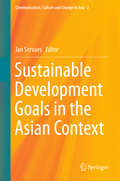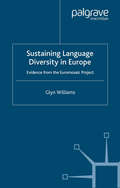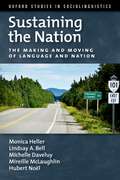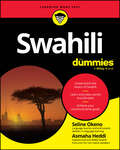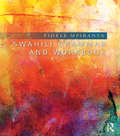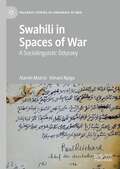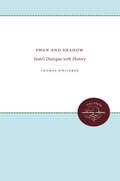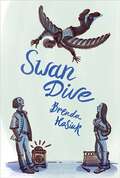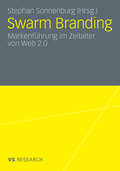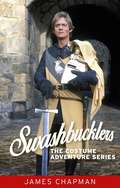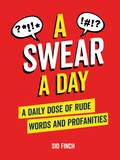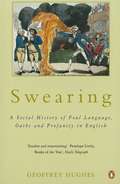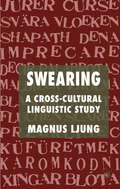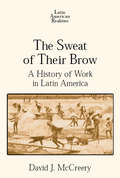- Table View
- List View
Sustainable Development Goals in the Asian Context (Communication, Culture and Change in Asia #2)
by Jan ServaesThis book presents research that focuses on Sustainable Development in Asia. Chapters are extended works of papers presented at Communication/Culture and The Sustainable Development Goals (CCSDG): Challenges for a New Generation, an international conference held in Chiang Mai University in December 2015. The chapters address assessments of Millennium Development Goals in several Asian countries and the region as a whole. The book also identifies and discusses the changes and potential improvements in the transition from Millennium Development Goals (2000-2015) to Sustainable Development Goals (2015-2030). Areas that are covered in the book, which are illustrated with case studies, include Corporate Social Accountability, Information and Communications Technologies, and Small Medium Enterprises (SMEs). The book serves as a useful resource for academics, scholars, students, and policymakers, interested in Development Studies.
Sustainable English Language Teacher Development at Scale: Lessons from Bangladesh
by Ian Eyres Tom Power Robert McCormickThis book offers a thorough and comprehensive review of the lessons learnt from the award-winning 'English in Action' English language teacher development programme, which ran in government primary and secondary schools across Bangladesh from 2008 to 2017. Over the course of nine years the programme involved 51,000 teachers and 20 million school students, demonstrably raising standards of teachers' classroom practice and students' English language attainment, and won the British Council ELTON Award for Local innovation (2013) and Times Higher Education Award for International Impact (2107).The sixteen chapters explore the programme in detail, looking at both the successes and the challenges encountered throughout its course, including the strategies used to address the challenges. The key innovative factors of the programme include: · a positive choice to build on the existing context, such as the lives and experiences of local teachers and the demands of a nationally determined curriculum; · teacher learning taking place in the teachers' own classrooms; · a focus on learning the 'how' of communicative language teaching through reflective practice and peer support; · the use - within a carefully constructed pedagogy - of affordable, readily-available mobile phone technology; · the use of mediated authentic video · a model of teacher development at very large scale that provided a successful alternative to the'cascade'model; · a partnership with government institutions to ensure that improved practices are maintained beyond the life of the Programme.
Sustainable English Language Teacher Development at Scale: Lessons from Bangladesh
by Ian Eyres Tom Power Robert McCormickThis book offers a thorough and comprehensive review of the lessons learnt from the award-winning 'English in Action' English language teacher development programme, which ran in government primary and secondary schools across Bangladesh from 2008 to 2017. Over the course of nine years the programme involved 51,000 teachers and 20 million school students, demonstrably raising standards of teachers' classroom practice and students' English language attainment, and won the British Council ELTON Award for Local innovation (2013) and Times Higher Education Award for International Impact (2107).The sixteen chapters explore the programme in detail, looking at both the successes and the challenges encountered throughout its course, including the strategies used to address the challenges. The key innovative factors of the programme include: · a positive choice to build on the existing context, such as the lives and experiences of local teachers and the demands of a nationally determined curriculum; · teacher learning taking place in the teachers' own classrooms; · a focus on learning the 'how' of communicative language teaching through reflective practice and peer support; · the use - within a carefully constructed pedagogy - of affordable, readily-available mobile phone technology; · the use of mediated authentic video · a model of teacher development at very large scale that provided a successful alternative to the'cascade'model; · a partnership with government institutions to ensure that improved practices are maintained beyond the life of the Programme.
Sustaining Action Research: A Practical Guide for Institutional Engagement (Research and Resources in Language Teaching)
by Anne Burns Emily Edwards Neville John EllisThis book is a practical guide for English language teachers and teacher educators seeking to carry out and promote teacher action research within their institutional context. Based on contemporary theory and a reflexive and social approach to teacher professional development and learning, it offers readers structured methodologies and concepts, wide-ranging hands-on activity sets, and focused suggestions for appropriate and sustainable ways to implement action research across an institution. Experts Anne Burns, Emily Edwards and Neville John Ellis close the book by presenting ideas for conducting teacher research through reflective practice, exploratory practice and action research.
Sustaining Action Research: A Practical Guide for Institutional Engagement (Research and Resources in Language Teaching)
by Anne Burns Emily Edwards Neville John EllisThis book is a practical guide for English language teachers and teacher educators seeking to carry out and promote teacher action research within their institutional context. Based on contemporary theory and a reflexive and social approach to teacher professional development and learning, it offers readers structured methodologies and concepts, wide-ranging hands-on activity sets, and focused suggestions for appropriate and sustainable ways to implement action research across an institution. Experts Anne Burns, Emily Edwards and Neville John Ellis close the book by presenting ideas for conducting teacher research through reflective practice, exploratory practice and action research.
Sustaining Language Diversity in Europe: Evidence from the Euromosaic Project (Palgrave Studies in Minority Languages and Communities)
by G. WilliamsAdopting a post-structuralist approach in analyzing the Euromosaic data about European minority language groups, Glyn Williams argues that different states construct minority language groups and speakers in different ways. This leads to an argument about the nature of democracy and how the current changes in governmental discourses accommodate linguistic and cultural diversity.
Sustaining the Nation: The Making and Moving of Language and Nation (Oxford Studies in Sociolinguistics)
by Monica Heller Lindsay A. Bell Michelle Daveluy Mireille McLaughlin Hubert NoëlThis book is an ethnography of labor mobility and its challenges to the idea of the nation. Using the example of francophone Canada, it examines how social difference-race, ethnicity, language, gender-has been used to sort out who must (or can) be mobile and who must (or can) remain in place in the organization of global circulation of human and natural resources. It argues that "francophone Canada" can best be understood as an ethnoclass category that has embedded francophones into specific forms of labor mobility since the beginnings of European colonization, even as their social difference has been constructed as national in the interests of gaining political power. The result has been an erasure both of francophone mobilities and of their contribution to the rooted community that lies at the heart of the idea of the nation, and of francophone capacity to resist economic marginalization and exploitation. By following French Canadian workers back and forth between eastern and central Canada and the frontiers of the Canadian northwest, Sustaining the Nation explores how contemporary forms of labor mobility make it increasingly difficult for national structures and discourses to produce the francophone nation. By following the ideological tensions between language as a skill and language as a marker of belonging, the authors present grounded evidence of how the globalized new economy challenges the nation-state, and how mobilities and immobilities are co-constructed.
The Svetlana Boym Reader
by Svetlana Boym Cristina Vatulescu Tamar Abramov Nicole G. Burgoyne Julia Chadaga Jacob Emery Julia VaingurtSvetlana Boym was a prolific writer, a charismatic professor, a novelist, and a public intellectual. She was also a fiercely resourceful and reflective immigrant; her most resonant book, The Future of Nostalgia, was deeply rooted in that experience. Even after The Future of Nostalgia carried her fame beyond academic circles, few readers were aware of all of her creative personas. She was simply too prolific, and her work migrated across most people's disciplinary boundaries-from literary and cultural studies through film, visual, and material culture studies, performance, intermedia, and new media.The Svetlana Boym Reader presents a comprehensive view of Boym's singularly creative work in all its aspects. It includes Boym's classic essays, carefully chosen excerpts from her five books, and journalistic gems. Showcasing her roles both as curator and curated, the reader includes interviews and excerpts from exhibition catalogues as well as samples of intermedial works like Hydrant Immigrants. It also features autobiographical pieces that shed light on the genealogy of her scholarly work and rarities like an excerpt from Boym's first graduate school essay on Russian literature, complete with marginalia by her mentor Donald Fanger. Last but not least, the reader includes late pieces that Boym did not live to see through publication, as well as transcripts of her memorable last lectures and performances.
The Svetlana Boym Reader
by Svetlana Boym Cristina Vatulescu Tamar Abramov Nicole G. Burgoyne Julia Chadaga Jacob Emery Julia VaingurtSvetlana Boym was a prolific writer, a charismatic professor, a novelist, and a public intellectual. She was also a fiercely resourceful and reflective immigrant; her most resonant book, The Future of Nostalgia, was deeply rooted in that experience. Even after The Future of Nostalgia carried her fame beyond academic circles, few readers were aware of all of her creative personas. She was simply too prolific, and her work migrated across most people's disciplinary boundaries-from literary and cultural studies through film, visual, and material culture studies, performance, intermedia, and new media.The Svetlana Boym Reader presents a comprehensive view of Boym's singularly creative work in all its aspects. It includes Boym's classic essays, carefully chosen excerpts from her five books, and journalistic gems. Showcasing her roles both as curator and curated, the reader includes interviews and excerpts from exhibition catalogues as well as samples of intermedial works like Hydrant Immigrants. It also features autobiographical pieces that shed light on the genealogy of her scholarly work and rarities like an excerpt from Boym's first graduate school essay on Russian literature, complete with marginalia by her mentor Donald Fanger. Last but not least, the reader includes late pieces that Boym did not live to see through publication, as well as transcripts of her memorable last lectures and performances.
Swahili For Dummies
by Seline Okeno Asmaha HeddiLearn the official language of Kenya and Tanzania Swahili For Dummies will teach you the basics of Swahili, so you can start conversing in Africa’s language of commerce. This book introduces you to the foundations of Swahili grammar and enables you to engage in basic conversations. With the simplified Dummies learning process, you’ll quickly get a grasp on the language, without complex terms and confusing explanations. You’ll also move through the book at a comfortable pace, so you’ll be familiar with what you’ve learned before moving on to more complex stuff. Focus on communication and interaction in everyday situations, so you can actually use the language you’re studying—right away. Understand the basics of Swahili Learn everyday words and phrases Gain the confidence to engage in conversations in Swahili Communicate while traveling and talk to Swahili-speaking family members Swahili For Dummies is for readers of all ages who want to learn the basics of Swahili in a no-stress, beginner-friendly way. Swahili teachers will also love sharing this practical approach with their students.
Swahili For Dummies
by Seline Okeno Asmaha HeddiLearn the official language of Kenya and Tanzania Swahili For Dummies will teach you the basics of Swahili, so you can start conversing in Africa’s language of commerce. This book introduces you to the foundations of Swahili grammar and enables you to engage in basic conversations. With the simplified Dummies learning process, you’ll quickly get a grasp on the language, without complex terms and confusing explanations. You’ll also move through the book at a comfortable pace, so you’ll be familiar with what you’ve learned before moving on to more complex stuff. Focus on communication and interaction in everyday situations, so you can actually use the language you’re studying—right away. Understand the basics of Swahili Learn everyday words and phrases Gain the confidence to engage in conversations in Swahili Communicate while traveling and talk to Swahili-speaking family members Swahili For Dummies is for readers of all ages who want to learn the basics of Swahili in a no-stress, beginner-friendly way. Swahili teachers will also love sharing this practical approach with their students.
Swahili Grammar and Workbook
by Fidèle MpiranyaSwahili Grammar and Workbook provides a practical and comprehensive companion to Swahili grammar, filling in gaps left by other textbooks. Presenting the essentials of Swahili grammar in a highly accessible fashion, it reduces complex language topics to helpful rules and mnemonic aids, enabling maximum grammar retention and accurate usage. Grammar points are followed by multiple examples and exercises, allowing students to consolidate and practice their learning. No prior knowledge of linguistic terminology is required. Key features include: Twenty five language notes covering key topics such as: personal pronouns; the Swahili noun class system; special class combinations; the imperative, the subjunctive, and the conditional moods; the use of comparatives; the use of monosyllabic verbs; the passive form and various other forms of verb extensions; the relative clause Clear, detailed and jargon-free grammatical explanations supported by an assortment of helpful diagrams, charts and tables and many relevant and up-to-date examples A wide range of communication-oriented exercises to reinforce learning and develop students’ ability to use Swahili actively Audio files to support pronunciation practice, clearly linked to relevant sections of the book and available for free download at http://www.routledge.com/books/details/9781138808263/ Four appendices, Swahili-English and English-Swahili vocabulary lists, a bibliography and an index presented at the back of the book for easy access to information. Written by a highly experienced instructor, Swahili Grammar and Workbook will be an essential resource for all students and teachers of Swahili. It is suitable for use both as a companion reference text in language courses and as a standalone text in independent grammar classes.
Swahili Grammar and Workbook
by Fidèle MpiranyaSwahili Grammar and Workbook provides a practical and comprehensive companion to Swahili grammar, filling in gaps left by other textbooks. Presenting the essentials of Swahili grammar in a highly accessible fashion, it reduces complex language topics to helpful rules and mnemonic aids, enabling maximum grammar retention and accurate usage. Grammar points are followed by multiple examples and exercises, allowing students to consolidate and practice their learning. No prior knowledge of linguistic terminology is required. Key features include: Twenty five language notes covering key topics such as: personal pronouns; the Swahili noun class system; special class combinations; the imperative, the subjunctive, and the conditional moods; the use of comparatives; the use of monosyllabic verbs; the passive form and various other forms of verb extensions; the relative clause Clear, detailed and jargon-free grammatical explanations supported by an assortment of helpful diagrams, charts and tables and many relevant and up-to-date examples A wide range of communication-oriented exercises to reinforce learning and develop students’ ability to use Swahili actively Audio files to support pronunciation practice, clearly linked to relevant sections of the book and available for free download at http://www.routledge.com/books/details/9781138808263/ Four appendices, Swahili-English and English-Swahili vocabulary lists, a bibliography and an index presented at the back of the book for easy access to information. Written by a highly experienced instructor, Swahili Grammar and Workbook will be an essential resource for all students and teachers of Swahili. It is suitable for use both as a companion reference text in language courses and as a standalone text in independent grammar classes.
Swahili in Spaces of War: A Sociolinguistic Odyssey (Palgrave Studies in Languages at War)
by Alamin Mazrui Kimani NjoguThis monograph examines the roles and functions of Swahili in war/conflict situations, and the impact of wars on the destiny of the language. Covering a period of over a century, the monograph explores this sociolinguistic theme in the context of six wars/conflicts: the Maji Maji resistance against German rule, the two World Wars, the anti-colonial resistance to British colonialism, the wars of the Great Lakes region, the cold wars, and the ongoing war against terrorism. In geographical focus, some of the war situations explored here are “local,” others are “transnational,” and others still rather “global” in scope and ramifications. In the final analysis, the monograph provides important snapshots of the conflict-based history of the Swahili language, demonstrating once again that language is a malleable tool that can be appropriated and galvanized to serve the interests of either party in a conflict and sometimes as a means of creating hegemonic and anti-hegemonic meanings.
Swan and Shadow: Yeats's Dialogue with History
by Thomas WhitakerHistory was central in a variety of ways to Yeats's poetic development and to the meaning of his work. In this study, Whitaker suggests that history was for the poet a mysterious interlocutor, which Yeats saw at times as a bright reflection of himself and again as a dark force opposed to that self. The poet's internal dialogue is viewed as projection into historical symbolism.Originally published in 1964.A UNC Press Enduring Edition -- UNC Press Enduring Editions use the latest in digital technology to make available again books from our distinguished backlist that were previously out of print. These editions are published unaltered from the original, and are presented in affordable paperback formats, bringing readers both historical and cultural value.
Swan Dive
by Brenda HasiukA teenage refugee adapts to a new country, a new language, new school and even finds a wonderful best friend, until the pressures of past and present collide and lead to a lie that changes everything. Refugees from the Bosnian War, Lazar’s family flees the Siege of Sarajevo and arrives in Winnipeg in the early 1990s. Despite various mini dramas unfolding at home, as his parents and older sisters navigate a new language, the bitter cold and a strange city and country, Lazar manages to find a place for himself at school, largely by making friends with Elle, a sassy, outspoken girl who divides her time between living with her hoarder mother (who stuffs their tiny apartment with bargains she finds at Liquidation World) and her hippie father, Jimmy, who lives in British Columbia. But as two geeky loners, Elle and Lazar are happy in their own bubble of friendship, especially after they form a pop duo and dream of making it big on Star Search. Soon Lazar’s desperate escape out of Sarajevo seems far away, even as the trauma of his broken homeland looms large with his family at home. Then Elle comes back from Vancouver after a summer at Jimmy’s, and things are different. They’re in high school, Elle has lost weight and blossomed into popularity, while Lazar remains small, skinny and forgettable. She seems to have forgotten all about their singing plans and starts spending time with a new kid, Ivan. Lazar is unmoored and filled with new longings — for Elle, for Ivan, for a sense that he belongs somewhere. His mother and older sisters worry about his health, that he’s so thin, that he’s not interested in sports, even though the doctors can’t find anything wrong. And then, in an impulsive moment, Lazar tells Ivan that he’s seriously ill. And with this one reckless lie he suddenly gets — and loses — everything he thought he wanted. Key Text Features author’s note historical context Correlates to the Common Core State Standards in English Language Arts: CCSS.ELA-LITERACY.RL.6.6 Explain how an author develops the point of view of the narrator or speaker in a text.
Swashbucklers: The costume adventure series (PDF)
by James ChapmanSwashbucklers is the first study of one of the most popular and enduring genres in television history – the costume adventure series. It maps the history of swashbuckling television from its origins in the 1950s to the present. It places the various series in their historical and institutional contexts and also analyses how the form and style of the genre has changed over time. And it includes case studies of major swashbuckling series including The Adventures of Robin Hood, The Buccaneers, Ivanhoe, William Tell, Zorro, Arthur of the Britons, Dick Turpin, Robin of Sherwood, Sharpe, Hornblower, The Count of Monte Cristo and the recent BBC co-production of The Three Musketeers.
Swashbucklers: The costume adventure series
by James ChapmanSwashbucklers is the first study of one of the most popular and enduring genres in television history – the costume adventure series. It maps the history of swashbuckling television from its origins in the 1950s to the present. It places the various series in their historical and institutional contexts and also analyses how the form and style of the genre has changed over time. And it includes case studies of major swashbuckling series including The Adventures of Robin Hood, The Buccaneers, Ivanhoe, William Tell, Zorro, Arthur of the Britons, Dick Turpin, Robin of Sherwood, Sharpe, Hornblower, The Count of Monte Cristo and the recent BBC co-production of The Three Musketeers.
A Swear A Day: A Daily Dose of Rude Words and Profanities
by Sid FinchNever be lost for dirty words again with an insult for every day of the year If you've ever been angry at your commute, stubbed your toe or broken a glass, swearing can help you vent and make you feel just a little bit better. Now you can get creative with your expletives with this witty collection of vulgar and versatile words. In this side-splitting little book, you will be armed with a swear word for every occasion, and ready to curse whatever life throws at you. Learn a new profanity each day, broaden your rude vocabulary and express yourself in new and entertaining ways. With well-known swear words, dirty phrases from the past, and insults in foreign languages, this book is complete with all the things you've ever wanted to say but didn't have the words for. The perfect book for a foul-mouthed friend, A Swear A Day is the hilarious way to say what you're really thinking.
Swearing: A Social History of Foul Language, Oaths and Profanity in English
by Geoffrey HughesTracing the history of swearing from ancient Anglo-Saxon traditions and those of the Middle Ages, through Shakespeare, the Enlightenment and the Victorians, to the Lady Chatterley trial and various current trends, Geoffrey Hughes explores a fascinating, little discussed yet irrespressible part of our linguistic heritage. This second edition contains a Postscript updating various contemporary developments, such as the growth of Political Correctness.
Swearing: A Cross-cultural Linguistic Study
by M. LjungThis study provides a definition and a typology of swearing and compares its manifestations in English and 24 other languages. In addition the study traces the history of swearing from its first known appearance in Ancient Egypt to the present day.
The Sweat of Their Brow: A History of Work in Latin America
by David McCreeryThroughout Latin America's history the world of work has been linked to race, class, and gender within the larger framework of changing social, political, and economic circumstances both in the region and abroad. In this compelling narrative, David McCreery situates the work experience in Latin America's broader history. Rather than organizing the coverage by forms of work, he proceeds chronologically, breaking 500 years of history into five periods: Encounter and Accommodation, 1480 -- 1550; The Colonial System, 1550 -- 1750; Cities and Towns, 1750 -- 1850; Export Economies, 1850 -- 1930; Work in Modern Latin America, 1930 -- the Present.Within each period, McCreery discusses the chief economic, political, and social characteristics as they relate to work, identifying both continuities and discontinuities from each preceding period. Specific topics studied range from the encomienda, the enslaving of Indians in Spanish America, the introduction of Black African slaves, labor in mining, agricultural labor, urban and domestic labor, women and work, peasant economies, industrial labor, to the maquilas and more.
The Sweat of Their Brow: A History of Work in Latin America
by David McCreeryThroughout Latin America's history the world of work has been linked to race, class, and gender within the larger framework of changing social, political, and economic circumstances both in the region and abroad. In this compelling narrative, David McCreery situates the work experience in Latin America's broader history. Rather than organizing the coverage by forms of work, he proceeds chronologically, breaking 500 years of history into five periods: Encounter and Accommodation, 1480 -- 1550; The Colonial System, 1550 -- 1750; Cities and Towns, 1750 -- 1850; Export Economies, 1850 -- 1930; Work in Modern Latin America, 1930 -- the Present.Within each period, McCreery discusses the chief economic, political, and social characteristics as they relate to work, identifying both continuities and discontinuities from each preceding period. Specific topics studied range from the encomienda, the enslaving of Indians in Spanish America, the introduction of Black African slaves, labor in mining, agricultural labor, urban and domestic labor, women and work, peasant economies, industrial labor, to the maquilas and more.
Swedish crime fiction: Novel, film, television (PDF)
by Steven PeacockSwedish crime fiction became an international phenomenon in the first decade of the twenty-first century, starting first with novels but then percolating through Swedish-language television serials and films and onto English-language BBC productions and Hollywood remakes. This book looks at the rich history of ‘Scandinavian noir’, examines the appeal of this particular genre and attempts to reveal why it is distinct from the plethora of other crime fictions. Examining the popularity of Steig Larsson’s international success with his Millennium trilogy, as well as Henning Mankell’s Wallander across the various media, Peacock also tracks some lesser-known novels and television programmes. He illustrates how the bleakness of the country’s ‘noirs’ reflects particular events and cultural and political changes, with the clash of national characteristics becoming a key feature. It will appeal to students and researchers of crime fiction and of film and television studies, as well as the many fans of the novels and dramatic representations.
